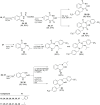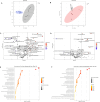Untargeted Diversity-Oriented Synthesis for the Discovery of New Antitumor Agents: An Integrated Approach of Inverse Virtual Screening, Bioinformatics, and Omics for Target Deconvolution
- PMID: 40705771
- PMCID: PMC12362587
- DOI: 10.1021/acs.jmedchem.5c01344
Untargeted Diversity-Oriented Synthesis for the Discovery of New Antitumor Agents: An Integrated Approach of Inverse Virtual Screening, Bioinformatics, and Omics for Target Deconvolution
Abstract
Molecular diversity is one of the most pursued objectives in drug discovery, and diversity-oriented synthesis (DOS) perfectly responds to the achievement of this goal. In this paper, we describe a DOS approach applied to the antitumor field with the aim of identifying new anticancer structures and their associated targets. To accomplish this ambitious project, after an initial stage of phenotypic evaluation, we set up an integrated platform of inverse virtual screening (IVS), bioinformatics, and omics to predict the biological targets of the most promising compounds 31 and 63. Several proteins emerged from this study, and the most interesting ones were assessed by biophysical and in cellulo experiments, leading to the validation of six targets involved in calcium regulation, endoplasmic reticulum stress, and apoptosis. This work allowed us to identify two hit compounds with an interesting antitumor mechanism, but principally, to validate our platform as a fruitful tool for untargeted DOS campaigns.
Figures
















Similar articles
-
The quantity, quality and findings of network meta-analyses evaluating the effectiveness of GLP-1 RAs for weight loss: a scoping review.Health Technol Assess. 2025 Jun 25:1-73. doi: 10.3310/SKHT8119. Online ahead of print. Health Technol Assess. 2025. PMID: 40580049 Free PMC article.
-
Prescription of Controlled Substances: Benefits and Risks.2025 Jul 6. In: StatPearls [Internet]. Treasure Island (FL): StatPearls Publishing; 2025 Jan–. 2025 Jul 6. In: StatPearls [Internet]. Treasure Island (FL): StatPearls Publishing; 2025 Jan–. PMID: 30726003 Free Books & Documents.
-
Systemic pharmacological treatments for chronic plaque psoriasis: a network meta-analysis.Cochrane Database Syst Rev. 2020 Jan 9;1(1):CD011535. doi: 10.1002/14651858.CD011535.pub3. Cochrane Database Syst Rev. 2020. Update in: Cochrane Database Syst Rev. 2021 Apr 19;4:CD011535. doi: 10.1002/14651858.CD011535.pub4. PMID: 31917873 Free PMC article. Updated.
-
Systemic pharmacological treatments for chronic plaque psoriasis: a network meta-analysis.Cochrane Database Syst Rev. 2021 Apr 19;4(4):CD011535. doi: 10.1002/14651858.CD011535.pub4. Cochrane Database Syst Rev. 2021. Update in: Cochrane Database Syst Rev. 2022 May 23;5:CD011535. doi: 10.1002/14651858.CD011535.pub5. PMID: 33871055 Free PMC article. Updated.
-
Systemic treatments for eczema: a network meta-analysis.Cochrane Database Syst Rev. 2020 Sep 14;9(9):CD013206. doi: 10.1002/14651858.CD013206.pub2. Cochrane Database Syst Rev. 2020. PMID: 32927498 Free PMC article.
References
-
- Sinha S., Vohora D.. Drug Discovery and Development. In Pharmaceutical Medicine and Translational Clinical Research. 2018:19–32. doi: 10.1016/B978-0-12-802103-3.00002-X. - DOI
-
- Lood C. S., Koskinen A. M. P.. Harmicine, a Tetracyclic Tetrahydro-β-Carboline: From the First Synthetic Precedent to Isolation from Natural Sources to Target-Oriented Synthesis (Review)*. Chem. Heterocycl. Compd. 2015;50(10):1367–1387. doi: 10.1007/s10593-014-1602-4. - DOI
LinkOut - more resources
Full Text Sources

